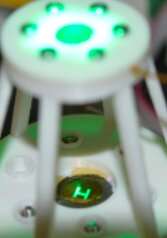July 23, 2021 feature
A curvy and shape-adaptive imager based on printed optoelectronic pixels

Curved imagers that can adjust their shape could have many valuable applications, for instance, aiding the development of more advanced medical imaging tools and cameras. Most existing flexible curvy imagers, however, are either not compatible with tunable focal surfaces or can only capture images with low resolutions and pixel fill factors.
Researchers at University of Houston and University of Colorado-Boulder have recently designed and created a curvy and shape-adaptive imager with high pixel fill factors. The new imager, presented in a paper published in Nature Electronics, was fabricated by transferring an array of ultrathin silicon optoelectronic pixels with a kirigami design onto curvy surfaces, using a technique known as conformal additive stamp printing.
"Curvy imaging sensor-based cameras, such as a human-like eyeball composed of retina and a lens, hold great promise for many critical applications," Cunjiang Yu, one of the researchers who carried out the study, told Phys.org. "Nonetheless, the development of such cameras entails many technical challenges, for instance associated with high pixel fill factor and shape tunability, two features that are necessary to capture clear images without optical aberration."
The objective of the recent study by Yu and his colleagues was to overcome the technical challenges previously encountered when trying to develop curvy and shape-adaptive imagers. In contrast with conventional digital cameras, in fact, curvy imaging sensors typically require multiple and complex lens combinations to take clear and high-resolution images.
The curvy imager developed by the researchers is inspired by the shape of human eyeballs. Just like a human eyeball, in fact, curvy cameras should be made of a curvy and shape adaptive imaging sensor array and a lens.

"Creating curvy imagers using conventional or existing technologies can be highly challenging," Yu explained. "The key novelty of our curvy imager is the novel, reliable and robust manufacturing technology, named conformal additive stamp (CAS) printing, which was invented by my research group."
First, Yu and his colleagues used mature microfabrication processes to create a planar shaped, very thin 32 x 32-pixel imaging sensor array, following a kirikami design (i.e., a variation of the Japanese art of origami that also involves cutting paper to create 3D objects, rather than just folding it). Subsequently, the researchers used a technique called CAS printing to create curvy imagers with desired shapes.
"The focal length of the lens and the curvature of the imaging sensor (or imager) can be tuned accordingly, to achieve adaptive optical focus and reduce aberration for imaging far and near objects, which even exceeds the capability of the human eye, since the human retina does not offer a similar level of tunability," Yu said.
The curvy imager exhibits a fill factor of 78% before stretching and can maintain its electrical performance under a 30% biaxial strain. In the future, it could have a number of valuable applications, for instance aiding the development of more advanced and better performing endoscopes, retinal prostheses, night vision goggles, artificial compound eye cameras and fisheye cameras.
"Our work paves way to achieve curvy, shape tunable adaptive/tunable imager with high pixel fill factor to guarantee imaging capture with high quality and low optical aberration," Yu said. "Our future research will be aimed at developing other high-performance imaging sensor pixels and arrays, and the aforementioned camera devices."
More information: Curvy, shape-adaptive imagers based on printed optoelectronic pixels with a kirigami design. Nature Electronics(2021). DOI: 10.1038/s41928-021-00600-1
Journal information: Nature Electronics
© 2021 Science X Network





















